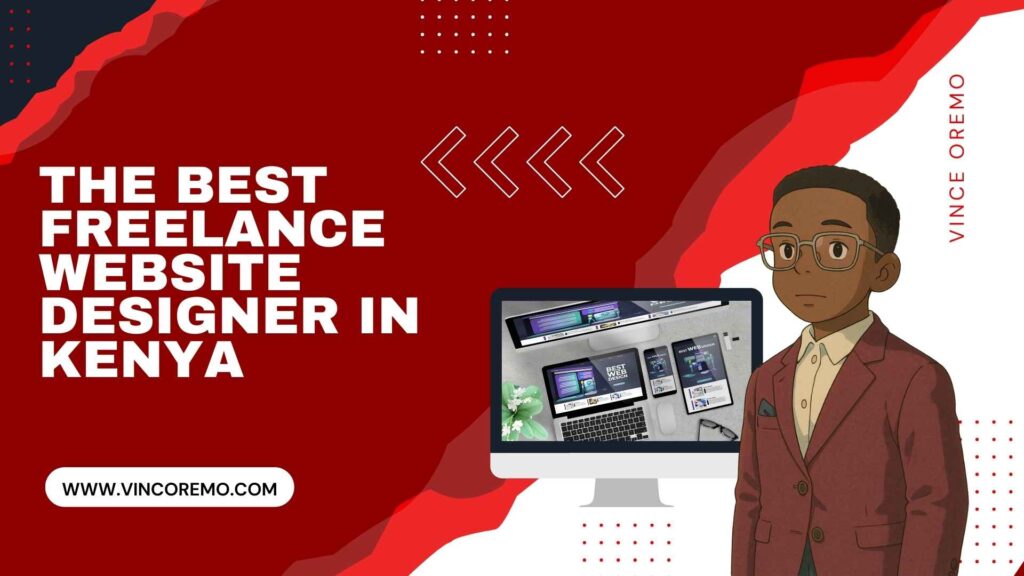Are you feeling confused about the costs involved in getting a website designed in Kenya? You’re not alone. Whether you’re a startup seeking a digital presence or an established business looking to revamp your site, understanding web design pricing can be daunting. In this guide, I’m here to break down everything you need to know about web design costs in Kenya for 2025.
I’m Vince Oremo, a dedicated web designer with years of experience in the Kenyan digital space. I’ve seen firsthand how an efficiently designed website can transform a business — and how transparent pricing can make this process less overwhelming. Together, we’ll explore the factors that influence costs, the range of packages available, and how you can get the best value for your investment.
Introduction
In the ever-evolving digital world, having a stunning and functional website is crucial for business success. However, as technology and design trends shift, so do the costs associated with web design.
In this guide, we’ll dissect the elements that determine web design pricing in Kenya and offer a clear picture of what to expect in 2025. From design complexity and functionality to SEO and maintenance, every component plays a role in shaping the final cost.
Whether you’re planning to build a new website or update an existing one, understanding these pricing factors will empower you to make an informed decision that maximizes your investment.
Key Pricing Factors
Web design pricing isn’t arbitrary—it’s driven by several crucial factors. Knowing these factors helps you understand why costs can vary widely from one project to another.
Design Complexity
The level of customization is one of the most significant cost drivers. A custom design that fully reflects your brand’s personality will generally cost more than using a ready-made template. Custom designs involve unique graphics, layout structures, and advanced user experience elements.
Functionality and Features
The features you need on your website, such as e-commerce capabilities, interactive elements, dynamic content, and integrated third-party tools, all add to the cost. More complex functionalities require additional development time, secure coding practices, and sometimes ongoing technical support.
Content Management System (CMS)
Whether you opt for a custom CMS or a popular platform like WordPress can influence costs. While premium CMS solutions offer greater flexibility, they might also come with higher implementation and maintenance fees.
SEO and Digital Marketing Integration
SEO isn’t an afterthought—it’s integrated into the design process. Effective SEO requires keyword research, optimized content, meta tags, and more. All these elements contribute to higher upfront costs but are vital for driving organic traffic in the long run.
Maintenance and Support
After your website is launched, ongoing maintenance and support ensure that it remains secure, current, and performing at its best. Many agencies offer maintenance packages that include regular updates, security checks, and occasional redesigns.
Local Market Factors
Web design pricing in Kenya can also be influenced by local market conditions, including the cost of living, availability of talent, and competitive landscape. In 2025, we expect these factors to continue impacting pricing structures.
Package Options and Cost Breakdown
One of the best ways to approach web design pricing is to understand the different package options available. Most web design companies in Kenya offer tiered packages tailored to various business needs and budgets.
Basic Package
The Basic Package is designed for startups and small businesses looking for a professional online presence without a lot of frills. This package typically includes:
- Template-based design customization
- Responsive design for mobile and desktop
- Basic CMS integration
- Essential SEO setup
- Standard hosting support
Prices for a Basic Package generally range from KES 30,000 to KES 70,000, depending on the scope and additional add-ons.
Standard Package
The Standard Package is ideal for growing businesses that require additional functionality and a more tailored design. In addition to the features offered in the Basic Package, the Standard Package typically includes:
- Custom design elements and graphics
- Enhanced SEO integration
- Advanced CMS features
- Social media integration
- Basic e-commerce capabilities (if needed)
Expect Standard Package pricing to fall between KES 70,000 and KES 150,000.
Premium Package
For businesses seeking a highly customized experience with advanced functionalities, the Premium Package offers a comprehensive solution. This package is fully tailored to your brand and can include:
- Fully custom design and bespoke graphics
- Advanced functionality and interactive features
- Full e-commerce integration
- Comprehensive SEO and digital marketing integration
- Ongoing maintenance and premium support
Premium Package pricing varies widely and can start at around KES 150,000 and go upwards depending on project complexity.
Note: These pricing estimates are based on current market trends and are expected to evolve with economic factors and technological advancements in 2025.
Balancing Cost and Quality
It’s important to remember that while cost is a significant factor, the value of a well-designed website extends far beyond the initial investment. A quality website can dramatically enhance your brand image, attract more visitors, and generate higher conversions.
When considering web design pricing, always weigh the cost against the potential return on investment. Investing a bit more upfront in quality design can result in significant savings and increased revenue in the long term through improved user experience and SEO performance.
Understanding the Web Design Process
A transparent design process is crucial to ensuring that the final product aligns with your vision and business goals. Let’s break down the typical steps involved in a web design project:
- Initial Consultation: We start with a detailed discussion about your business, objectives, and the specific functionality you require. This stage helps in setting clear expectations and outlining the scope of the project.
- Planning & Strategy: Next, a comprehensive plan is developed, including a sitemap and wireframes. This strategy outlines the structure of your site and ensures a logical flow that enhances user experience.
- Design & Prototyping: Our creative team then develops design mockups that reflect your brand’s identity. We collaborate closely with you during this phase, refining the design based on your feedback.
- Development & Integration: Once the design is finalized, we begin the development stage using the latest technologies. This phase includes coding, CMS integration, and ensuring that the website is fully responsive.
- Testing & Quality Assurance: Comprehensive testing is conducted to check for any bugs, performance issues, or compatibility problems across various devices and browsers.
- Launch & Maintenance: After successful testing, we launch your website. Ongoing support and maintenance ensure that your website stays updated and secure.
For more insights into our workflow, visit our Process page.
Industry Insights and Trends in Web Design Pricing
The landscape of web design is continuously evolving, and staying updated on industry trends is vital. In Kenya, factors such as advances in technology, increasing mobile usage, and the growing importance of SEO are shaping pricing models.
As we look forward to 2025, expect to see more integration of advanced technologies like artificial intelligence, automation, and data-driven design improvements. These innovations promise to enhance functionality and user experience, which in turn can affect pricing structures.
Additionally, local economic factors and the demand for quality digital experiences will continue to play a significant role in determining web design costs. Staying informed about these trends will help you make more strategic decisions regarding your investment.
Tips for Getting the Best Value for Your Web Design Investment
Maximizing your return on investment in a web design project requires careful planning and evaluation. Here are some tips to help you get the best value:
- Define Clear Objectives: Know what you want to achieve with your website—whether it’s increased sales, better customer engagement, or improved brand recognition. A clear vision will guide the entire project.
- Research and Compare Packages: Evaluate different service providers and packages. Look at portfolios, read reviews, and compare what is included in each package to ensure you’re getting a well-rounded service.
- Invest in Quality: While affordability is important, remember that a high-quality website offers long-term benefits in terms of user experience, SEO, and conversion rates.
- Understand the Process: A transparent process means fewer surprises. Choose a provider who clearly outlines their workflow—from discovery to maintenance.
- Ask for Case Studies: Case studies and testimonials provide real-world examples of how a web design service has delivered value to other businesses.
- Plan for Ongoing Support: Web design is not a one-off investment. Ongoing maintenance and updates ensure that your website continues to perform optimally as technology and market trends evolve.
Taking the time to plan and research thoroughly will help you secure a solution that is both cost-effective and high-performing.
Additional Resources
To further empower your decision-making, explore these additional resources that provide valuable insights into web design pricing and industry trends in Kenya:
- Responsive Web Design Case Study
- SEO and Organic Traffic Growth Case Study
- Email Marketing Case Study
- Video Marketing Case Study
- Copywriting and Blog Content Case Study
- AI, Automation and Chatbot Case Study
- Top 10 Web Hosting Companies in Kenya 2025
- Ultimate Guide to Building a Killer Website
- Our Process
- Contact Us
Conclusion & Next Steps
Understanding web design pricing in Kenya doesn’t have to be confusing. By breaking down the factors that influence cost, exploring various package options, and reviewing industry insights, you can make a well-informed decision that aligns with your business goals.
A professionally designed website is an essential asset for any small business—it’s not just a digital placeholder but a robust marketing tool that drives growth and builds trust. In 2025, expect even more innovation, smarter integrations, and more competitive pricing structures as the market evolves.
If you’re ready to invest in a website that offers both affordability and quality, now is the time to act. Start by consulting with experts who understand your unique needs and can offer transparent, customized solutions.
Schedule a discovery call today by visiting our Contact page, and let’s begin the journey towards building a website that not only meets but exceeds your expectations.
Thank you for taking the time to read this guide. I look forward to helping your small business thrive in the digital age.
Vince Oremo
Freelance Website Designer in Kenya





